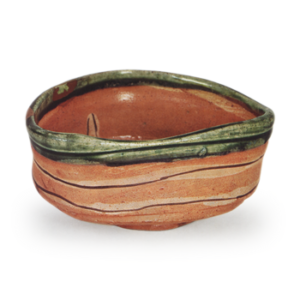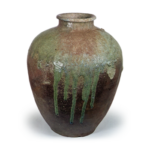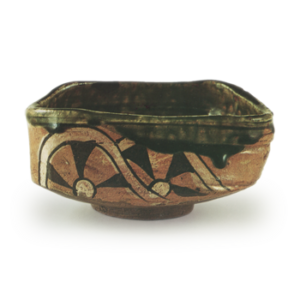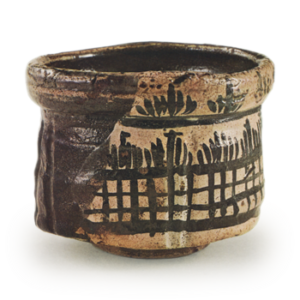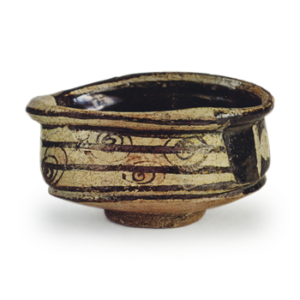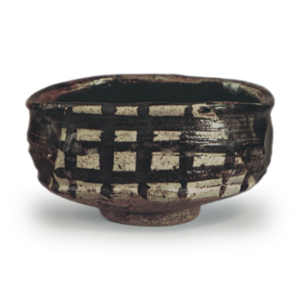Tamba ware is also one of the representative old kilns since the Middle Ages, but an overview of the style from Momoyama to early Edo shows that it is a kiln with a different character from the purely fired ceramics of Bizen, Shigaraki, and Iga. From the medieval period to the Momoyama period, the pottery was mainly fired using anagama and semi-aboveground anagama kilns, and after the early Edo period, glazed pottery was mainly used in climbing kilns. In Tamba ware from the medieval to the early modern period, it was during the Muromachi period (1336-1573) that the kiln truly showed its status as one of Japan’s representative kilns, and like other old kilns, it left behind imposing style pieces such as jars. However, during the Keicho period, the traditional anagama kiln was parted with and a Karatsu-style climbing kiln suitable for mass production of glazed ceramics was introduced, probably under the influence of the Mino and Kyoto kilns, and the distinctive glazed ceramics that are generally referred to as Tamba ware today were produced.
The late Shigeo Sugimoto wrote about Tamba ware in detail in his book “The Old Kilns of Tamba,” and I will outline the history of Tamba ware according to his theory.
Tamba’s old kilns are located in Taki and Hikami counties in Hyogo Prefecture and in Kyoto Prefecture, but most of what is generally referred to as Tamba ware was fired in kilns scattered throughout Kamitateki-, Shimotateki-, Kamaya, and Kamiaino in Taki County. Sugimoto divides the history of Tamba pottery into three periods: the first Onohara period, the second Kamaya period, and the third Satogama period. The second period of the kamaya period was the Keicho period (1596-1615). The second Kamaya period, from the end of the Keicho era to the first year of the Horeki era (1751), includes Kamaya (Nakasuji), Kamiaino (Kamaya Nishi, Kamaya Higashi, Tobigao Kita, Tobigao Minami, and Tanaka Nishi). The Kamaya kiln may have had a semi-aboveground anagama in the early period, but it was mostly converted to a climbing kiln, and the potter’s wheel was used for molding.
The third period, the satogama period, began after 1752 (Horeki 2), and pottery was fired in the kamaya (south and center), shita-tachikake (south, center, north, and south shita-tachikake), and kami-tachikake (south, main, and north) kilns.
The name Onohara-period refers to the fact that this area was once called Onohara-sho, and all Onohara-period wares are wheel-thrown cord-shaped pieces, which are fired in the same manner as other kilns in the Middle Ages. The surface of the vessels is coated with natural glaze, and while oxidizing firing was the basic firing method, some pieces are characterized by a strong reduction and the bluish tint of the natural glaze. From the late Muromachi period to the Keicho period, a very small amount of tea ceramics were produced, but not as large as in Bizen, indicating that this was a backward kiln, influenced by other kilns. In the kamaya period, the style of pottery changed from cord making to wheel throwing, with the wheel being a kick wheel and the kiln being a climbing kiln. Thereafter, glazed wares became the main type of pottery, with red dobe, ash-dara, candy, and white glazes being fired. The red dobe glaze is especially characteristic of Tamba ware, with a bright red clay body. The glaze called “haidara” is a glaze made by sprinkling iron on clay ash, which is also unique to Tamba ware. The production of tea ceremony utensils during the kamaya period seems to have been dominated by folk utensils, as there were few excellent tea ceremony utensils produced. However, among tea ceramics, a series of tea ceramics favored by Enshu are highly regarded for their elegant style. From this period onward, more and more spatula- and comb-shaped pieces were produced, and later, leaf-shaped pieces were also produced. Among the Tamba ceramics of this period, the Sansho jar, made to hold the Asakura pepper, a specialty of Tamba, is well known.
Even during the Muromachi period (1333-1573), it is difficult to distinguish between Bizen and Tamba, but after the Keicho period, it is assumed that potters from other kilns often came to Tamba to engage in pottery production. The inscription “Made by Genbei, a native of Bizen,” on a large pottery vessel inscribed in 1657 (Meireki 3), suggests one aspect of this.
In addition, since this collection mainly contains Tamba ceramics from the Keicho period to the Edo period, we would like to briefly note some facts about Tamba tea ceremony ceramics. Tamba tea ceramics did not appear in major Momoyama tea ceremonies until 1611, the latest among the representative old kilns since the Middle Ages, and there are certainly few examples of tea ceramics produced before the Keicho period.
According to “Yurakutei Chayu Nikki (Diary of a Tea Ceremony at Yurakutei)” by Oda Yurakusai, on the morning of March 29, Keicho 16, Yurakusai used a tea caddy with the inscription “Charyu Tanba yaki hagatsuki (tea caddy with a shoulder). It is interesting to note that the tea caddy is described as “handmade,” and it is not clear if it was handmade by Yurakusai or by Yuraku. In general, however, there are very few Tamba ceramics that are thought to have been made during the Keicho period, and compared to Bizen, Iga, and Mino ceramics, they seem to have been very weak.
However, since flower vases and water jars in the Oribe style were produced, it is certain that tea ceremony utensils were made in response to orders from tea masters from the late Keicho period.
It is clear that Kobori Enshu had excellent tea ceramics fired in Tamba. According to the “Muneho-shi’s Tools and Preparations for Tea Ceremonies,” on May 23, Kan’ei 7, “I. Tea bowl, Tanba ware-, Water jar, Tanba ware,” and on September 4, the following year, “-, Water drop (water drop shaped tea container), Tanba ware,” are written. Furthermore, on the 22nd of the same month, there is “I. Tea caddy Ikuno,” where the famous “Ikuno” tea caddy illustrated in the figure also appears. There is no doubt that “Ikuno” was Enshu’s favorite, and as one of the so-called Enshu seven kilns, it tells us that there was a special relationship between Enshu and a kiln shop somewhere in Tamba at this time.
Furthermore, the diary of Hourin Seisho of Kinkakuji, “Baika-ki ji,” also mentions “one Tamba ware flower vase” on March 8, Shoho 3. Although we do not know what kind of ceramics were used, it is likely that most of the Tamba ceramics produced after Enshu became involved with Tamba were glazed with black or brown glaze, and the workmanship was quite elegant. In general, however, Tamba was not a first-rate production center for tea ceramics.
The style of Tamba ceramics is not as distinctive as that of Bizen or Iga.
Tamba ware, one of the oldest kilns with a long tradition since the Middle Ages, was mainly produced in jars. After the Momoyama period (1573-1600), when the kilns began to produce tea ceremony ceramics, the types of pottery varied considerably, but from the Muromachi period to the early Momoyama period, jars and pots were the main type of pottery. In other old kilns, ground bowls were often fired, but these are extremely rare in Tamba. Until the early Momoyama period (the Hakka kiln period), the pottery was similar to that of Bizen, but when climbing kilns were built, glazed ware began to be fired, and among these, the so-called Yamafuku jar, used to store Yamashuku, a local specialty, is most famous.
Among the Bizen, Tamba, Iga, and Shigaraki kilns of the Momoyama period, Tamba ware seems to have the fewest tea ceramics and the least individuality. In particular, flower vases and water jars that make a strong impression like those produced by Bizen and Iga are extremely rare, and there are probably less than ten masterpieces that can be compared to their counterparts. While Bizen actively embraced the demand for Wabicha after the Tenbun period, Tamba seems to have been very reluctant to do so. The difference in geographical conditions between Bizen, where works could be transported by ship, and Tamba, a village in the mountains, seems to have played a major role. After the Keicho era, however, climbing kilns were constructed in place of anagama kilns, and glazed pieces were fired in a variety of styles, but there are still few flower vases, water jars, or tea bowls to be seen. In the Edo period (1603-1867), there were some interesting and distinctive pieces of folk art, such as tokuri (Japanese tea utensils).
